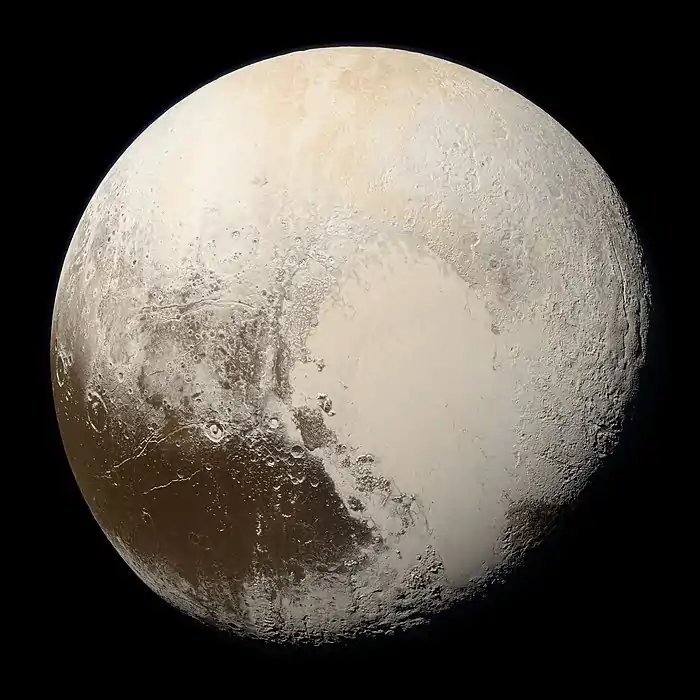(523639) 2010 RE64
(523639) 2010 RE64, provisional designation 2010 RE64, is a trans-Neptunian object in the scattered disc located in the outermost region of the Solar System, approximately 570 kilometers (350 miles) in diameter. It was discovered on 11 July 2010 by the Pan-STARRS-1 survey at the Haleakala Observatory, Hawaii, in the United States.[1] American astronomer Michael Brown considers it a "highly likely" dwarf planet.[5]
| Discovery [1] | |
|---|---|
| Discovered by | Pan-STARRS 1 |
| Discovery site | Haleakala Obs. |
| Discovery date | 11 July 2010 |
| Designations | |
| (523639) 2010 RE64 | |
| 2010 RE64 | |
| TNO [2] · SDO[3] distant [1] | |
| Orbital characteristics [2] | |
| Epoch 27 April 2019 (JD 2458600.5) | |
| Uncertainty parameter 3 · 2 [1] | |
| Observation arc | 7.47 yr (2,729 d) |
| Aphelion | 94.746 AU |
| Perihelion | 36.443 AU |
| 65.595 AU | |
| Eccentricity | 0.4444 |
| 531.27 yr (194,045 d) | |
| 320.94° | |
| 0° 0m 6.84s / day | |
| Inclination | 13.550° |
| 67.306° | |
| ≈ 17 December 2076[4] ±2.4 days | |
| 20.572° | |
| Physical characteristics | |
Mean diameter | 561 km[5] 584 km (est. at 0.09 and H=4.4)[6] 350–780 km (for 0.25–0.05 albedo and H=4.4)[6] |
| 0.09 (est.)[5] | |
| 21.45[7] | |
| 4.4[1][2] 4.6[5] | |
Classification and orbit
2010 RE64 has an observation arc of 1774 days,[7] and there are currently no known precovery images to help refine its orbit. It is currently 53.7 AU from the Sun.[7] Based on JPL's best-fit solution for the orbit, it reached aphelion around 1829. It is estimated to come to perihelion around 2079.[2] Although the discovery is credited to Pan-STARRS, the object was first announced in a Minor Planet Electronic Circular by American astronomers David Rabinowitz, Megan Schwamb and Suzanne Tourtellotte observing from La Silla Observatory on 9 September 2010.[8]
Numbering and naming
This minor planet was numbered by the Minor Planet Center on 25 September 2018 (M.P.C. 111778).[9] As of 2018, it has not been named.[1]
Physical characteristics
Assuming a generic trans-Neptunian albedo of 0.09, it is about 580 kilometers in diameter.[6] However, since the true albedo is unknown and it has an absolute magnitude of 4.4,[2] it could easily be from about 350 to 780 km in diameter (for typical albedos of 0.05 to 0.25).[6] Michael Brown estimates a similar diameter of 561 kilometers, also using a geometric albedo of 0.09 and a fainter 4.6 absolute magnitude.[5]
References
- "523639 (2010 RE64)". Minor Planet Center. Retrieved 8 October 2018.
- "JPL Small-Body Database Browser: 523639 (2010 RE64)" (2017-12-30 last obs.). Jet Propulsion Laboratory. Retrieved 8 October 2018.
- Marc W. Buie. "Orbit Fit and Astrometric record for 10RE64" (last observation: 2011-10-21 using 16 of 16 observations over 1.1 yr). SwRI (Space Science Department). Archived from the original on 22 June 2011. Retrieved 3 December 2009.
- JPL Horizons Observer Location: @sun (Perihelion occurs when deldot changes from negative to positive. Uncertainty in time of perihelion is 3-sigma.)
- Brown, Michael E. "How many dwarf planets are there in the outer solar system?". California Institute of Technology. Retrieved 8 October 2018.
- "Asteroid Size Estimator". CNEOS NASA/JPL. Retrieved 8 October 2018.
- "AstDyS – (523639) 2010 RE64". Department of Mathematics, University of Pisa, Italy. Retrieved 15 August 2019.
- "MPEC 2010-T36 : 2010 RE64". IAU Minor Planet Center. 6 October 2010. Retrieved 6 July 2011.
- "MPC/MPO/MPS Archive". Minor Planet Center. Retrieved 8 October 2018.
External links
- Discovery Circumstances: Numbered Minor Planets (520001)-(525000) – Minor Planet Center
- (523639) 2010 RE64 at AstDyS-2, Asteroids—Dynamic Site
- (523639) 2010 RE64 at the JPL Small-Body Database

_(cropped).jpg.webp)
